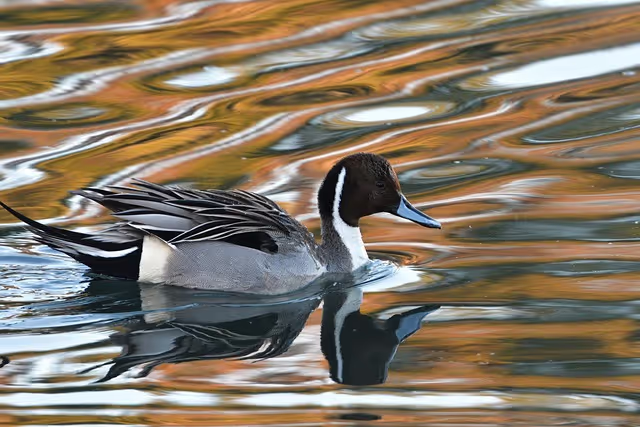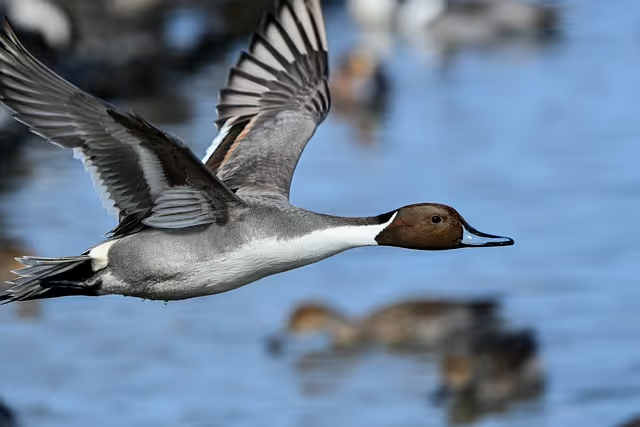The Northern Pintail


The Northern Pintail is one of the most elegant birds that the Pacific Northwest has to offer. They have beautiful beaks, long necks, slender profiles, and soft eyes. While the tails of both males and females are long and pointed, you will notice this feature more prominently on breeding males than non-breeding males and all females. Breeding male Northern Pintails stand out amongst other birds, with a shiny white breast and a beautiful white line down head and neck, which are both chocolate brown in color. Females and molting males are mottled in assorted shades of brown and white, with unmarked pale tan faces and dark bills. In flight, males flash a green speculum (the bird's inner wing feathers) while females flash a bronzy speculum.

Northern Pintails forage in order to find the food they eat. In shallow water, they up-end, with their head down in the water and their tail pointed upwards. If they're swimming, they will submerge their heads and necks to eat what lies in the mud that can often be found underneath the water's surface. They also forage by walking on land. The Northern Pintail's diet consists mostly of plant material in the fall and winter months. They particularly like the seeds of sedges, grasses, and pondweeds. They also like to eat waste grain from fields. In the spring and summer months, roots and new growth become part of the Northern Pintail's diet.The summer months also find the Northern Pintail eating more animal matter, such as insects, mollusks, and crustaceans. Young ducklings mostly eat insects.

Generally, Northern Pintails enjoy being in crowded environments, and are quite happy to interact with other ducks during the nonbreeding season. However, that changes when the breeding season begins during the latter half of winter. Northern Pintails begin forming pairs on their winter range, and continue the process during their annual spring migration. Several males often try to court the same female, which can lead to pursuit flights. The nesting site is on dry ground in and among short vegetation. The site is usually located near a body of water, but can be up to half a mile away. Females build the nest, which consists of a shallow depression that is lined with twigs, leaves, and grasses. Down is added afterwards. The nest is typically more exposed than the nests of other ducks. Northern Pintails build their nests in croplands, seasonal wetlands, grasslands, shortgrass prairies, and wet meadows. Outside of breeding season, Northern Pintails spend time in lakes, ponds, bays, tidal marshes, and wetlands.
Northern Pintails lay anywhere from six to twelve eggs. The eggs are pale olive in color. The incubation process takes approximately three to four weeks to complete, and is handled exclusively by the female. A few hours after the young hatch, the female leads them from the nest. They are able to feed themselves from birth. The young can typically fly anywhere from thirty-eight to fifty-two days after hatching. However, in the far northern parts of Canada and Alaska, which are among the Northern Pintail's most common breeding grounds, the young may develop faster as continuous daylight in the late spring and early summer months allows feeding to occur at all hours of the day.

Northern Pintails are fairly large birds. They have a wingspan of 34 inches (86.4 centimeters), and are 20.1 to 29.9 inches long (51 to 76 centimeters). They weigh anywhere from 17.6 to 51.1 ounces (500 to 1,450 grams). They are members of the Anseriformes order of birds, and the Anatiade family. The Northern Pintail's scientific name is Anas acuta. In Spanish, they are known as Ánade Rabudo. In French, they go by Canard pilet. While the species is still a common sight in the sky, the population is in decline. They are wary birds at all times of the year, but become especially so during the late summer period. That is when they are in the midst of the stage of their molt, in which they don't fly.
If you want to see a Northern Pintail in person, you might be in for a long wait as they only appear on the Washington Coast in the winter months. However, if you head across the Cascade Mountains and visit South Central Washington, there is a chance that you will be able to spot them now as the species can be found there year round. Look for groups of ducks that stand taller than the rest, as their long necks and slender profiles make it easy to distinguish them from other species. Good luck!
References
1. https://www.allaboutbirds.org/guide/Northern_Pintail/id
2. https://www.allaboutbirds.org/guide/Northern_Pintail/overview
3. https://www.audubon.org/field-guide/bird/northern-pintail
© Ian D. Caldwell, July 2021
Touch whale bones, examine shipwreck artifacts and connect with the coast's living history.

Support our mission, get involved in educational programs, or contribute through donations and volunteering.